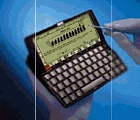epocemx allows to self-develope applications for er5 by GNU C/C++ Compiler, with lots of utilities.
It's better to install all products distributed at epocemx
Project Page. emxuser.sis is recommended to install into C: drive, and others into D: drive, in deference to performance of Psion 5/5mx. In that case, d:/emx is linked to usr as default. If emxuser was installed into another drive, usr needs to link to installed drive, as follow:
cd /
rm usr
ln -s driveletter:/emx usr
Header files and Library files of Symbian ER5 C/C++ SDK (
download page) are not allowed to be re-distributed, by the User License Agreement of Symbian. Necessitate files depend on a program which would be compiled.
epoc32\include\libc\*.h
epoc32\include\libc\arpa\*.h
epoc32\include\libc\machine\*.h
epoc32\include\libc\netinet\*.h
epoc32\include\libc\sys\*.h
epoc32\release\marm\rel\*.o
epoc32\release\marm\rel\*.lib
I made a zip archive of them and extract necessitate files on each product.
But under such circumstances it's impossible to compile a console program. For that, copy euser.lib to emx/lib/ and rename it libeuser.a. And,
gcc -g -Wall -ohello hello.c
Such a thing could be done.
- under constructing
There are two methods. One is modification of source codes and compiling. Another is very easy just to edit 'Psi85.app' and 'Ti85.dll' by a binary-editor.
At first, install Psi85.sis normally into D: drive, and copy Ti85 rom image to d:\system\apps\Psi85\Ti85.rom (Ti85.rom is the name of rom image file).
If you have no binary-editor,
FileDump for EPOC is recommended.
And open 'Psi85.app' and search "C:", so you find two discriptions at 004730(address) and 004A41(address). Overwrite them by "D:".
In same way, overwrite "C:" by "D:" at 01ED9C(address) of 'Ti85.dll'.
That's all, for ver.0.90
The application would make a file named 'Psi85' in c:\documents, which seems to be a ram image file. You can move it and rename as your pleasure. It works just like an alias for the program.
Machine epsilon is better to be small for numerical calculating, and reliability of handling epsilon is absolutely concern for numerical calculating, scientific calculating in particular.
e.g. Newton-Raphson method, QL implicit method, et cetra
Psion's machine epsilon is conforming to 'double' of IEEE(754) as follow:
2^-52 = (around) 2.22044604925031e-16
That's advanced reliable on Psion Sheet application and OPL compiler, emxepoc GNU C/C++ Compiler, and so on. In depth, click following pointer:
